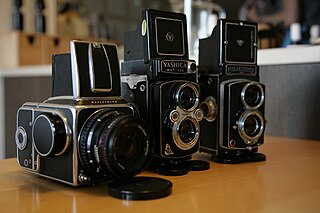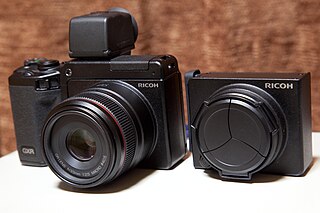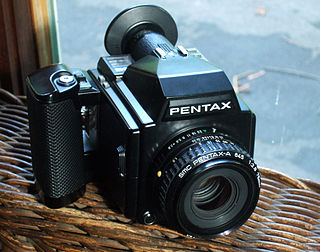Related Research Articles

Medium format has traditionally referred to a film format in photography and the related cameras and equipment that use film. Nowadays, the term applies to film and digital cameras that record images on media larger than the 24 mm × 36 mm used in 35 mm photography, but smaller than 4 in × 5 in.

Pentax is a brand name owned by Hoya Corporation and used under license by the Japanese multinational imaging and electronics company Ricoh for DSLR cameras, lenses, sport optics, and CCTV optics. The Pentax trade mark is owned by Hoya Corporation which also uses the Pentax brand as "Pentax Medical" for medical products & services, TI Asahi for surveying instruments, and Seiko Optical Products for certain optical lenses.

The Ricoh Company, Ltd. is a Japanese multinational imaging and electronics company. It was founded by the now-defunct commercial division of the Institute of Physical and Chemical Research (Riken) known as the Riken Concern, on 6 February 1936 as Riken Sensitized Paper. Ricoh's headquarters are located in Ota, Tokyo.
Digital Negative (DNG) is a patented, open, lossless raw image format developed by Adobe and used for digital photography. Adobe's license allows use without cost on the condition that the licensee prominently displays text saying it is licensed from Adobe in source and documentation, and that the license may be revoked if the licensee brings any patent action against Adobe or its affiliates related to the reading or writing of files that comply with the DNG Specification. It was launched on September 27, 2004. The launch was accompanied by the first version of the DNG specification, plus various products, including a free-of-charge DNG converter utility. All Adobe photo manipulation software released since the launch supports DNG.

A digital single-lens reflex camera is a digital camera that combines the optics and the mechanisms of a single-lens reflex camera with a solid-state image sensor and digitally records the images from the sensor.

Advanced Photo System type-C (APS-C) is an image sensor format approximately equivalent in size to the Advanced Photo System film negative in its C ("Classic") format, of 25.1×16.7 mm, an aspect ratio of 3:2 and Ø 31.15 mm field diameter. It is therefore also equivalent in size to the Super 35 motion picture film format, which has the dimensions of 24.89 mm × 18.66 mm and Ø 31.11 mm field diameter.
This article discusses the cameras – mainly 35 mm SLRs – manufactured by Pentax Ricoh Imaging Corp. and its predecessors, Pentax Corporation and Asahi Optical Co., Ltd.. Pentax must not be confused with Pentax 6x7 or Pentax 67 which are 120 medium format 6x7cm film cameras.

Pentax lenses were first badged as Takumar. The Takumar branded lenses were well respected for their line of Super Takumar, which designated the high performance coating applied to the lens as well as the optical formulas used to make them. The majority of the industry at the time was still satisfied with the variations of the "plumb" coating process and later some of the two and three layer processes as well. Asahi Pentax soon introduced the Takumar Super-Multi-Coated line of lenses which was a 7 layer process as the industry had just caught up with similar forms of 5 layer multi-coated optics. Eventually Asahi Optical and Pentax slowly shifted much of their lens production under the Pentax name and transitioned some of the successful designs that were first introduced under the Takumar name to use Asahi/Pentax badging as well as beginning to use the "smc" abbreviation. Eventually the Asahi partnership disappeared and the Pentax name became solely used. Pentax lenses saw many feature changes to answer the market, such as: incorporating "Auto-Aperture" with the M42, the light weight and compactness with the 'M' series, Aperture Priority overrides with the 'A' series, and Auto-Focus with the 'F' series. Modern Pentax lenses for digital SLR cameras have seen the elimination of the aperture ring completely as found on Pentax DA and D-FA series lenses. They use the Pentax KAF mount. All of these lenses have an autofocus feature, either operated from the camera body or from an internal SDM motor. Pentax compatible lenses are also made by third-party companies.

The Ricoh GXR is a compact digital camera first announced by Ricoh Company, Ltd, Tokyo on November 10, 2009. Unlike conventional cameras which either have a fixed lens and sensor or interchangeable lens and a fixed sensor, the GXR takes interchangeable units, each housing a lens, sensor and image processing engine. This allows each unit to have these features optimised to one another and a specific task, whereas with conventional interchangeable lens cameras, each different lens must use the same sensor and engine. The sealed units also prevent dust from reaching the sensor, which can be a problem with other cameras where the sensor is exposed whilst a lens is being changed. A significant disadvantage of this system is the extra cost involved in having to buy a whole new sensor with every new lens.

A mirrorless camera is a photo camera featuring a single, removable lens and a digital display. The camera does not have a reflex mirror or optical viewfinder like a digital single-lens reflex (DSLR) camera, but may have an electronic viewfinder. Many mirrorless cameras retain a mechanical shutter. Like a DSLR, a mirrorless camera accepts any of a series of interchangeable lenses compatible with its lens mount.
The Pentax Q series is a series of mirrorless interchangeable-lens cameras made by Pentax and introduced in 2011 with the initial model Pentax Q. As of September 2012, it was the world's smallest, lightest interchangeable lens digital camera. The first models used a 1/2.3" back-illuminated sensor CMOS image sensor. The Q7, introduced in June 2013, uses a larger 1/1.7" type sensor. The Q system is now discontinued.

Pentax K-01 is a mirrorless interchangeable-lens camera announced in February 2012. It uses the Pentax K mount.

The Pentax 645 is a medium format single-lens reflex system camera manufactured by Pentax. It was introduced in 1984, along with a complementary line of lenses. It captures images nominally 6 cm × 4.5 cm on 120, 220, and 70 mm film, though the actual size of the images is 56 mm × 41.5 mm.

The Pentax Q is a mirrorless interchangeable-lens camera introduced by Pentax on June 23, 2011.
The Pentax Q7 is a compact digital mirrorless interchangeable lens camera announced by Pentax on June 12, 2013. While the camera has a larger sensor than its predecessors, the Q and Q10, it is compatible with existing Q series lenses.

The Ricoh GR is a digital large sensor compact camera announced by Ricoh on April 17, 2013, one of a number of Ricoh GR digital cameras. It was succeeded by the Ricoh GR II in 2015 and the Ricoh GR III in 2019.

The Pentax K-1 is the first production Pentax full-frame digital SLR camera. As the flagship model of the Pentax K-mount system, it includes several new and improved features, including a five-axis SR II in-body image stabilization system, newly designed flexible tilt articulating screen mounted on four metal struts allowing for rotation about the optical axis in addition to upward and downward tilt, and improved autofocus and metering systems.

The Pentax KP is a 24 megapixel compact APS-C AA-filterless digital SLR camera announced by Ricoh on January 25, 2017. It features a PRIME IV image processor with an "image accelerator unit" that supports its operation up to ISO 819,200. It has a 1/6000s conventional and 1/24,000s electronic shutter. In terms of bracketing modes, it adds depth of field and shutter speed bracketing. The Pentax KP uses the Pentax K-mount interchangeable lens system.

The HD Pentax-D FA* 50mm f/1.4 SDM AW lens is a professional normal prime lens for the Pentax K-mount. It was officially announced on October 27th 2017, launched on June 28th 2018, and first shipped on July 26th 2018.
The HD Pentax-D FA* 85mm f/1.4 SDM AW lens is a professional short telephoto prime lens for the Pentax K-mount. The lens was officially announced on February 26, 2019, launched on June 25, 2020 and announced to be first shipped on June 26, 2020.